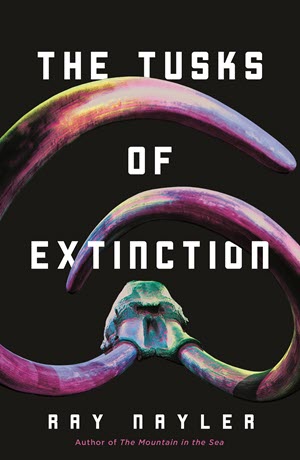The Tusks of Extinction
 Bringing animals back from extinction has been a fascination of science fiction at least since Jurassic Park, probably much longer. Usually what people want is dinosaurs, but the wooly mammoth also holds a significant place in the human imagination, and resurrecting it seems slightly less unlikely.
Bringing animals back from extinction has been a fascination of science fiction at least since Jurassic Park, probably much longer. Usually what people want is dinosaurs, but the wooly mammoth also holds a significant place in the human imagination, and resurrecting it seems slightly less unlikely.
Ray Nayler clearly knows his biology. In The Tusks of Extinction he correctly notes that mammoth fur was not orange, no matter what the creatures found frozen in Siberia might look like. In life the fur would have been a chocolate brown colour. It fades when it gets frozen. Also Nayler knows that extracting actual mammoth DNA from those Siberian corpses is not going to be possible. What might be possible, and indeed has been trialed on mice, is implanting genes for furriness in modern elephants.
A creature manufactured in this way is, of course, described as transgenic – it has crossed genes – and it may well be mice transformed in this way (they look adorable) that Donald Trump was thinking of when he went off on a rant about “transgender mice”.
Back with Nayler, his interest is not just in mammoths, but also in the fate of elephants, and by extension most of the natural world. Mammoths are extinct now. Elephants will be extinct in the not too distant future. The fewer elephants there are, the more valuable ivory becomes, and the more money and effort will be put into hunting them.
Nayler’s heroine, Damira, is a conservationist specialising in elephants who has dedicated her life to fighting poachers. We also catch up with her in the future where her mind has been implanted into that of a genetically manufactured ‘mammoth’. These poor creatures were reared in zoos and have no idea how to survive in the wild, let alone in the frozen wastes of Siberia where there is at least land that is not wanted by humans and can therefore become a wildlife sanctuary.
The idea of putting human minds into animals is not new, of course. If you would like to see it done very well, at novel length, I warmly recommend The Many Selves of Katherine North by Emma Geen. I’ve put my review of that book, originally hosted on my blog, in this issue.
Back with Nayler, what his novella is actually about is the economics of conservation. There are two opposing viewpoints here. One holds that the only way we are going to save the natural world is to make it valuable to humans. That means, among other things, eating meat, and allowing a certain level of hunting. The alternative view is that all animals are sovereign beings in their own right, and should not be killed by humans for any reason. The problem with that approach is that stopping humans killing animals is a monumental task, and probably the only way to make it stick is to kill most of the humans. Nayler hints at this, but doesn’t make it explicit. I got the impression that he favours the ‘kill most of the humans’ plan, which is a bit worrying.

Title: The Tusks of Extinction
By: Ray Nayler
Publisher:
Purchase links:
Amazon UK
Amazon US
See here for information about buying books though Salon Futura